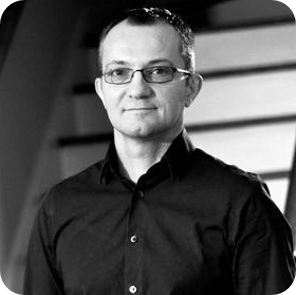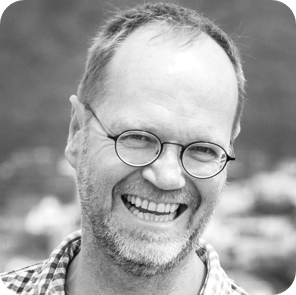


Mathias Meyer is currently Software Manager, R&D, for Rigaku Oxford Diffraction. Mathias received his DM in mineralogy from the Technical University of Berlin and his Ph. D. in 1997 from the Institut de Cristallographie of the Université de Lausanne under the supervision of Chapuis Gervais. From 1997 to 2000 Dr. Meyer continued teaching at the Université de Lausanne and began developing software for Kuma Diffraction Instruments Sàrl. In 2000, Kuma was merged into Oxford and Dr. Meyer has developing and managing the development of CryAlisPro since.

Dr. Pierre Le Magueres obtained a Ph.D. in physical chemistry and small molecule crystallography at the University of Rennes (France) in 1995, working under Dr. Lahcene Ouahab on the synthesis and analysis of molecular materials combining inorganic polyoxometalates and organic cation radicals based on tetrathiofulvalene derivatives. From 1996 to 2000, Dr. Le Magueres worked as a postdoctoral researcher with renowned Prof. Jay Kochi at the University of Houston, where he pursued his work on the synthesis and X-ray characterization of air-sensitive cation radicals and charge transfer complexes. In 2000, deciding to broaden his horizons and learn protein crystallography, Dr. Le Magueres joined the biochemistry department at the University of Houston and worked as a postdoctoral researcher with Prof. Kurt Krause on the design and X-ray characterization of potential new inhibitors for alanine racemase, a protein essential for the growth of infectious diseases such as tuberculosis. Dr. Le Magueres was hired in 2004 as a protein crystallographer in the Life Sciences department at Rigaku. After 14 years in protein crystallography, he shifted to a position as a small molecule crystallographer at Rigaku Americas Corporation in The Woodlands, TX. While still helping with protein crystallography if needed, Dr Le Magueres’ duties are now centered on the analysis of small molecule samples and the development of hardware and software products at Rigaku for small molecule crystallography.

Dr. Christian Schürmann studied Chemistry at the Georg-August-University in Göttingen (Germany), where he also graduated as PhD in the fields of chemical crystallography and experimental charge-density. As for experimental charge density, data quality is highly important and each step of data processing can contribute to – or compromise – data quality, an in-depth knowledge of the data processing steps, i.e. data integration, are part of his expertise. He joined Rigaku in 2019 and is now supporting Rigaku’s clients all over the Europe/Middle East/Africa region.

Dr. Christian Göb is working as an application scientist for Rigaku Europe SE. He obtained his doctorate in supramolecular chemistry from the RWTH Aachen University (Germany) and worked as a visiting scientist at the Graduate School of Engineering Science, Osaka University (Japan). His expertise lies in application and characterization of large assemblies like molecular cages, their inclusion compounds and polymers (two-dimensional networks, metal and covalent organic frameworks). His main responsibilities include demonstrations and trainings for users of single crystal diffraction instruments, assistance in crystallographic questions, preparation of publication material and application of the crystalline sponge method in the EMEA region.

Earlier in his career, Horst Puschmann was a synthetic inorganic chemist who relied heavily on X-Ray diffraction as an analytical technique. He found some of the crystallographic tools that were available at the time a little trying and moved gradually from complaining about this into actually trying to improve crystallographic software so that it can be used by any everyday chemist. Working in Prof. Judith Howards lab in Durham, Horst met Oleg Dolomanov in around 2004 and Olex2 was born. Oleg and Horst have been developing Olex2 ever since.

Fraser White began his career as a crystallographer under the tutelage of Professor Simon Parsons in the Chemistry department at the Univeristy of Edinburgh in 2004. Following completion of his PhD, he stayed at Edinburgh, accepting the position of staff crystallographer tasked with running the departmental X-ray crystallography service. During this time Fraser solved and refined over 1000 structures for a variety of different sample chemistries and gained broad experience in solving crystallographic problems. After several years in this role, Fraser first joined Agilent technologies in 2011 as an applications scientist based in Oxfordshire and remained with the company through the acquisition of Agilent’s single crystal business by Rigaku in 2015. Now in the role of product marketing manager for Rigaku Oxford Diffraction, Fraser is involved in the scientific aspects of single-crystal product marketing.

Dr. Jakub Wojciechowski is an application scientist working in the Rigaku Europe SE office based in Germany. Before Jakub joined Rigaku, he spent seven years as a crystallographer, research scientist and lecturer at the Łódź University of Technology in, Łódź, Poland. During this period, Jakub regularly collaborated with synthetic chemists, very often providing crucial information for publications, which is absolute structure results. Jakub is now responsible for supporting Rigaku’s clients in the Europe/Middle East/Africa region, helping them with data collection and processing, and also crystal structure publication.

Mark Del Campo is a Senior Applications Scientist at Rigaku Americas Corporation with over 20-years-experience in the life sciences. He has traveled the world supporting Rigaku’s macromolecular crystallography and small angle X-ray scattering customers for 9 years. Mark did his postdoctoral research on fungal DEAD-box proteins and Group I and Group II introns with Dr. Alan Lambowitz at the University of Texas at Austin, where he solved 8 structures deposited in the PDB. Mark received his Ph.D. under the supervision of Dr. James Ofengand at the University of Miami, where he worked on E.coli pseudouridine synthases and solved 3 structures deposited in the PDB. Mark was the recipient of both predoctoral and postdoctoral Ruth L. Kirschstein National Research Service Awards.

Bernhard Spingler is a Titularprofessor at the University of Zurich, Switzerland. He started with practical crystallography at the end of his Chemistry studies at the University of Basel in 1995. He continued with his PhD studies at the same institution and then did a postdoc at the Massachusetts Institute of Technology from 1998-2000 during which he crystallized and solved the X-ray structure of an oxaliplatin adduct to DNA. He has been at the University of Zürich since 2000, where his research group works on photodynamic therapy (PDT) and the method development of crystallization with the help of robots. He is (co)author of 181 peer-reviewed publications, has contributed more than 580 entries in the Cambridge Structure Database and 19 entries in the Protein Databank.